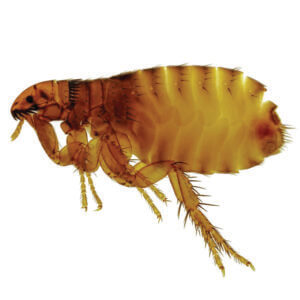There is no denying our pets are full-fledged members of the family. Just like the rest of your family, your goal is to love them but also to keep them healthy and safe. We do have to keep in mind that they are animals, though, and will do animal things. They will dig in the dirt, chase anything from birds to butterflies, and track more than just dirt into your home. The dog could have a spider hanging out on its back. Your cat could have picked up a tick while exploring and being extra curious. But, those are the least of your worries when you think about the inside of your home. It’s the pest that is naturally attracted to your pet and can wreak havoc on a home that you are most worried about: fleas.
Giving your cats and dogs monthly tick and flea treatments, having the occasional spa day with a flea shampoo or bath, and using flea collars will help with part of the flea issues you could have. Don’t forget about the rest of the spots and areas that can have flea issues other than your pet. If you only treat your pet, you could be looking at dealing with fleas over and over again. Getting the facts and demystifying the myths is the first step toward the knowledge you need to keep those furry friends safe.
Myth #1: The Preventive Flea Methods I Used Didn’t Work
Not exactly. The method you used probably did take care of any of the fleas that bit your pet. That’s how many of them work. Fleas take a bite, whatever is in the bloodstream of the pet doesn’t agree with them and just like that, the fleas die. But that will only take care of those fleas – and those only represent about 5 percent of the fleas you may have. The rest are compiled of fleas that have jumped off Spot as well as flea larvae and cocoons. You don’t necessarily need to blame the treatment method. It may have worked just like it was supposed to. You just have to add an additional flea treatment to take care of the rest.
But that will only take care of those fleas – and those only represent about 5 percent of the fleas you may have. The rest are compiled of fleas that have jumped off Spot as well as flea larvae and cocoons. You don’t necessarily need to blame the treatment method. It may have worked just like it was supposed to. You just have to add an additional flea treatment to take care of the rest.
Myth #2: Fleas Aren’t in My Home – They Are on My Pet
Sorry. How we wish this wasn’t a myth. The reality of the situation is if Polly had a hitchhiking flea, there are more where that came from and they aren’t just on Polly. The fleas that jump off your pet will make up about 50 percent of your flea population. Those fleas most likely jumped off and landed on your floors, carpets, and furniture. Since 5 percent are on your pet, what about the rest? Flea cocoons will make up about 10 percent. The cocoons will hatch into baby fleas in about a month. Larvae will most likely make up the extra 35 percent. These larvae actually sustain themselves by feeding on the adult flea feces as they move around your home (gross). Fifty percent are actually eggs, though, and lots of them. Once they hatch, you will have a flea infestation on your hands that you were probably not prepared for.
Myth #3: Nobody Can Treat for Fleas in a Home
No, sir. While it’s true that homeowners shouldn’t be the ones treating their homes for fleas, a professional certainly can and should. When it comes to DIY treatment methods, many if not all of them repel pests. That means, they will leave the area being treated – but not necessarily leave your house. They will either move to another room or just find a better hiding spot. That over-the-counter treatment just made your infestation worse and harder to treat. Best not to take this into your own hands. A professional pest control company will be able to treat for fleas using the correct product to deal with fleas in any stage of their life cycle – all while using the product safely. They should also be able to treat any exterior areas their professional inspection turned up evidence of fleas. Since your pet clearly got them from somewhere around your home, it could be an outlying area where a wild animal that has fleas has set up residence. Only a trained eye will be able to find that source and treat it correctly, so you don’t invite fleas back into your home.
The bites can bring some real issues with them for both the human and the canine or feline members of your family.  Fleabites are pretty distinctive. They look like small, red bumps in clusters of three or four or a straight line. They don’t swell up like mosquito bites, but you could notice a red “halo” around the bite center. Take care not to misidentify a tick bite for a flea bite.
Fleabites are pretty distinctive. They look like small, red bumps in clusters of three or four or a straight line. They don’t swell up like mosquito bites, but you could notice a red “halo” around the bite center. Take care not to misidentify a tick bite for a flea bite.
For both humans and pets, the bites are very itchy and the skin around each bite can be sore. Because of the itch, excessive scratching can cause a bacterial infection around the bite. You could also experience hives or develop a rash. Fleabites can also cause an allergic reaction in people who are sensitive to them. Symptoms can range from raised welts on the skin to difficulty breathing. Fleabites can also cause complications in pets, such as allergic reactions and even anemia from blood loss. As if you needed any other reason to take care of the fleas that have made their way into your home.
Listen, it’s the nature of both your dog and your cat to run around in the fresh air, and you want to give them the opportunity to burn off some of that wild energy. You just want to be able to provide it to them safely, too. Since fleas will enter your home, it’s also about the human family members. The more you know about fleas and what to do should you see your little Lexi itching too much, the more prepared you will be. After the call to the vet, call in a pro to take care of the fleas in and around your home. Nose boops on our kittens and puppies are always better without fleas.